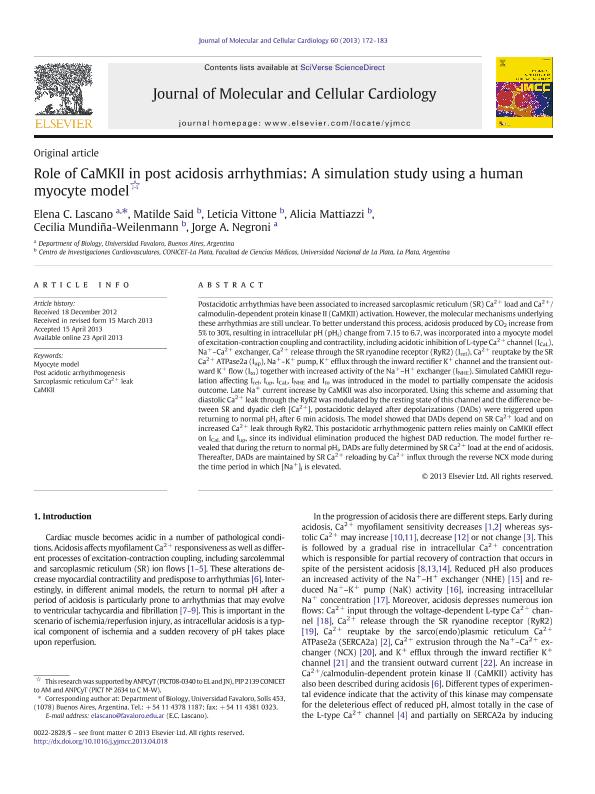Artículo
Role of CaMKII in post acidosis arrhythmias: A simulation study using a human myocyte model
Lascano, Elena Catalina; Said, Maria Matilde ; Vittone, Leticia Beatriz
; Vittone, Leticia Beatriz ; Mattiazzi, Ramona Alicia
; Mattiazzi, Ramona Alicia ; Mundiña, Cecilia Beatriz
; Mundiña, Cecilia Beatriz ; Negroni, Jorge Antonio
; Negroni, Jorge Antonio
 ; Vittone, Leticia Beatriz
; Vittone, Leticia Beatriz ; Mattiazzi, Ramona Alicia
; Mattiazzi, Ramona Alicia ; Mundiña, Cecilia Beatriz
; Mundiña, Cecilia Beatriz ; Negroni, Jorge Antonio
; Negroni, Jorge Antonio
Fecha de publicación:
07/2013
Editorial:
Academic Press Ltd - Elsevier Science Ltd
Revista:
Journal of Molecular and Cellular Cardiology
ISSN:
0022-2828
Idioma:
Inglés
Tipo de recurso:
Artículo publicado
Clasificación temática:
Resumen
Postacidotic arrhythmias have been associated to increased sarcoplasmic reticulum (SR) Ca2 + load and Ca2 +/calmodulin-dependent protein kinase II (CaMKII) activation. However, the molecular mechanisms underlying these arrhythmias are still unclear. To better understand this process, acidosis produced by CO2 increase from 5% to 30%, resulting in intracellular pH (pHi) change from 7.15 to 6.7, was incorporated into a myocyte model of excitation-contraction coupling and contractility, including acidotic inhibition of L-type Ca2 + channel (ICaL), Na+–Ca2 + exchanger, Ca2 + release through the SR ryanodine receptor (RyR2) (Irel), Ca2 + reuptake by the SR Ca2 + ATPase2a (Iup), Na+–K+ pump, K+ efflux through the inward rectifier K+ channel and the transient outward K+ flow (Ito) together with increased activity of the Na+–H+ exchanger (INHE). Simulated CaMKII regulation affecting Irel, Iup, ICaL, INHE and Ito was introduced in the model to partially compensate the acidosis outcome. Late Na+ current increase by CaMKII was also incorporated. Using this scheme and assuming that diastolic Ca2 + leak through the RyR2 was modulated by the resting state of this channel and the difference between SR and dyadic cleft [Ca2 +], postacidotic delayed after depolarizations (DADs) were triggered upon returning to normal pHi after 6 min acidosis. The model showed that DADs depend on SR Ca2 + load and on increased Ca2 + leak through RyR2. This postacidotic arrhythmogenic pattern relies mainly on CaMKII effect on ICaL and Iup, since its individual elimination produced the highest DAD reduction. The model further revealed that during the return to normal pHi, DADs are fully determined by SR Ca2 + load at the end of acidosis. Thereafter, DADs are maintained by SR Ca2 + reloading by Ca2 + influx through the reverse NCX mode during the time period in which [Na+]i is elevated.
Archivos asociados
Licencia
Identificadores
Colecciones
Articulos(CIC)
Articulos de CENTRO DE INVEST.CARDIOVASCULARES (I)
Articulos de CENTRO DE INVEST.CARDIOVASCULARES (I)
Citación
Lascano, Elena Catalina; Said, Maria Matilde; Vittone, Leticia Beatriz; Mattiazzi, Ramona Alicia; Mundiña, Cecilia Beatriz; et al.; Role of CaMKII in post acidosis arrhythmias: A simulation study using a human myocyte model; Academic Press Ltd - Elsevier Science Ltd; Journal of Molecular and Cellular Cardiology; 60; 1; 7-2013; 172-183
Compartir
Altmétricas



